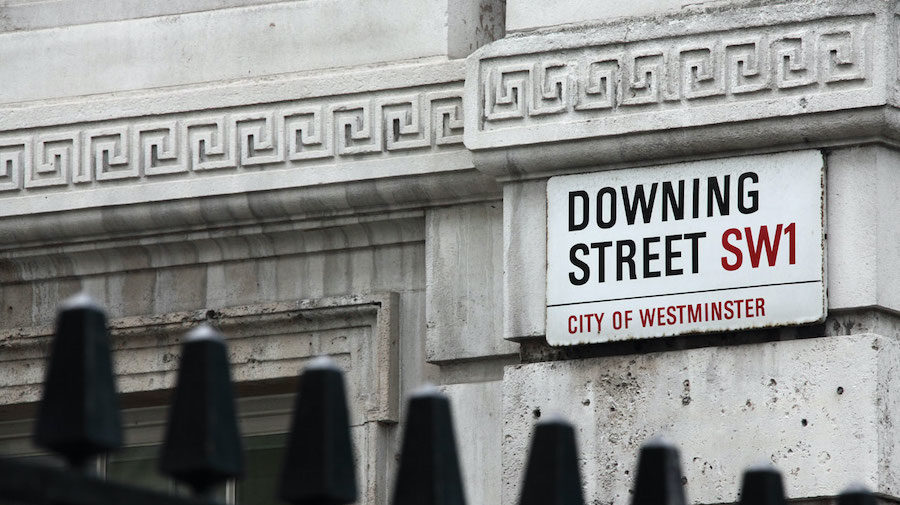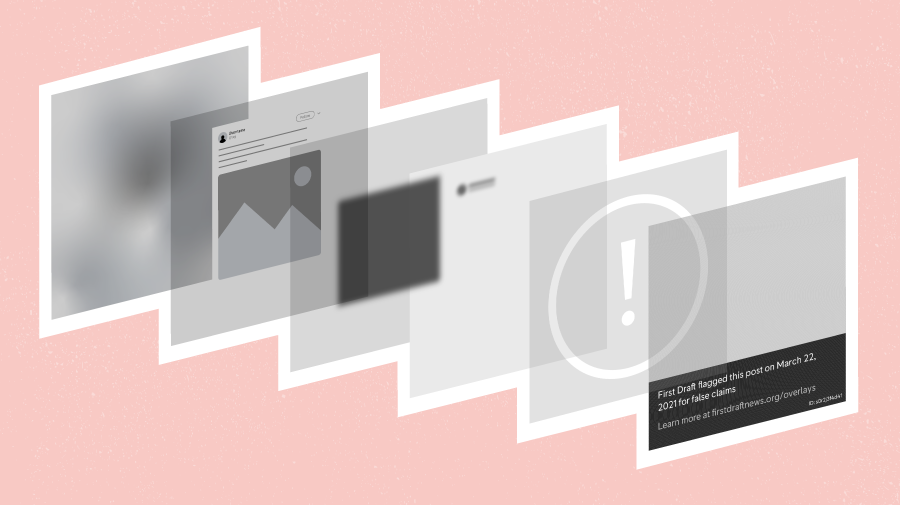Six weeks of campaigning ahead of the UK’s 2019 general election have finally come to a close. Boris Johnson and his Conservative Party returned to power with 365 seats in British Parliament – a considerable majority.
The weeks leading up to the vote came with multiple controversies to the detriment of quality information. Political parties battled each other with parody websites, fake newspapers and doctored videos; Facebook ads containing misleading claims spread far and wide; and fabricated or imposter tweets surfaced after the London Bridge terror incident and throughout the campaign.
In the final week, First Draft’s collaborative CrossCheck project spotlighted issues with voting at polling stations on election day, disinformation used to discredit marginalised voices, and how a hospital became the focal point of disinformation just days before the election.
Check out First Draft’s round-ups of disinformation and media manipulation from previous weeks during the UK election:
- December 7, 2019 – UK general election 2019: Boris Johnson quote disputed, more suspicious Facebook ads and party publications get the magazine treatment
- November 30, 2019 – UK general election 2019: Fabricated tweets, pre-printed ballots and more fake newspapers
- November 22, 2019 – UK General Election 2019: CCHQ’s fact-check stunt, fake newspapers and a squirrel hoax dominate the third week
- November 15, 2019 – UK General Election 2019: Doctored videos, fake accounts and suspicious ads surface in the second week
- November 9, 2019 – UK General Election 2019: The false, misleading and suspicious claims CrossCheck uncovered in the first week
Voter suppression claims and fake predictions on election day
On election day, First Draft was on the lookout for polling-related disinformation across the country, with a focus on claims of voter suppression and disturbances at booths. Here’s what we found.
As with the previous six weeks, politicians were one source of voter misinformation. In the marginal seat of Bolton West, the Labour candidate tweeted a photo of a local polling station with a wheelchair ramp blocked by cones and tape, captioned “people with disabilities literally blocked from casting their vote in Horwich”.
However, the Conservative candidate was quick to clarify there were “clear signs for disability access just to the right of this photograph”, which Bolton Council confirmed.
Fortunately, I voted at this polling station in Horwich this morning and there were clear signs for disability access just to the right of this photograph. Don’t let Labour deter you from voting. https://t.co/gWUHQ0R7SJ
— Chris Green (@CGreenUK) December 12, 2019
As for disinformation disseminated by official sources, a Conservative party Facebook post published on the morning of election day contained the debunked claim that Labour would impose an “additional £2,400 tax bill per year”. It also included the misleading claims that Labour would introduce “open borders” and a “holiday tax”.
Several social media users also reported seeing sensationalised, fly-posted posters that demonised Labour leader Jeremy Corbyn with the question “would you trust this man with your children?”
In some areas, local police were called in to deal with the “orchestrated campaign” of posters spotted near polling stations across the country. First Draft saw examples crop up in Teesside, Sheffield, Northampton, as well as reports in Broxtowe and London.
The placards bear the name and address of ‘Campaign Against Corbynism’, an organisation directed by a weekend reporter for the right-leaning Daily Express. First Draft has previously investigated the Facebook ads associated with this campaign, when Bickerton confirmed his involved with the Campaign Against Corbynism Facebook Page, but he has not responded to requests for comment on the placards.
These placards have been put up all over Northampton lampposts. Dirty campaigning. pic.twitter.com/YyPV2D6Br2
— Natalie Bloomer (@natalie_bloomer) December 12, 2019
Social media users also spread disinformation about the date of the election, a common tactic seen in elections globally.
There were tweets spreading rumours that different parties’ supporters should vote on different days – fortunately, none of the posts identified gained significant traction.
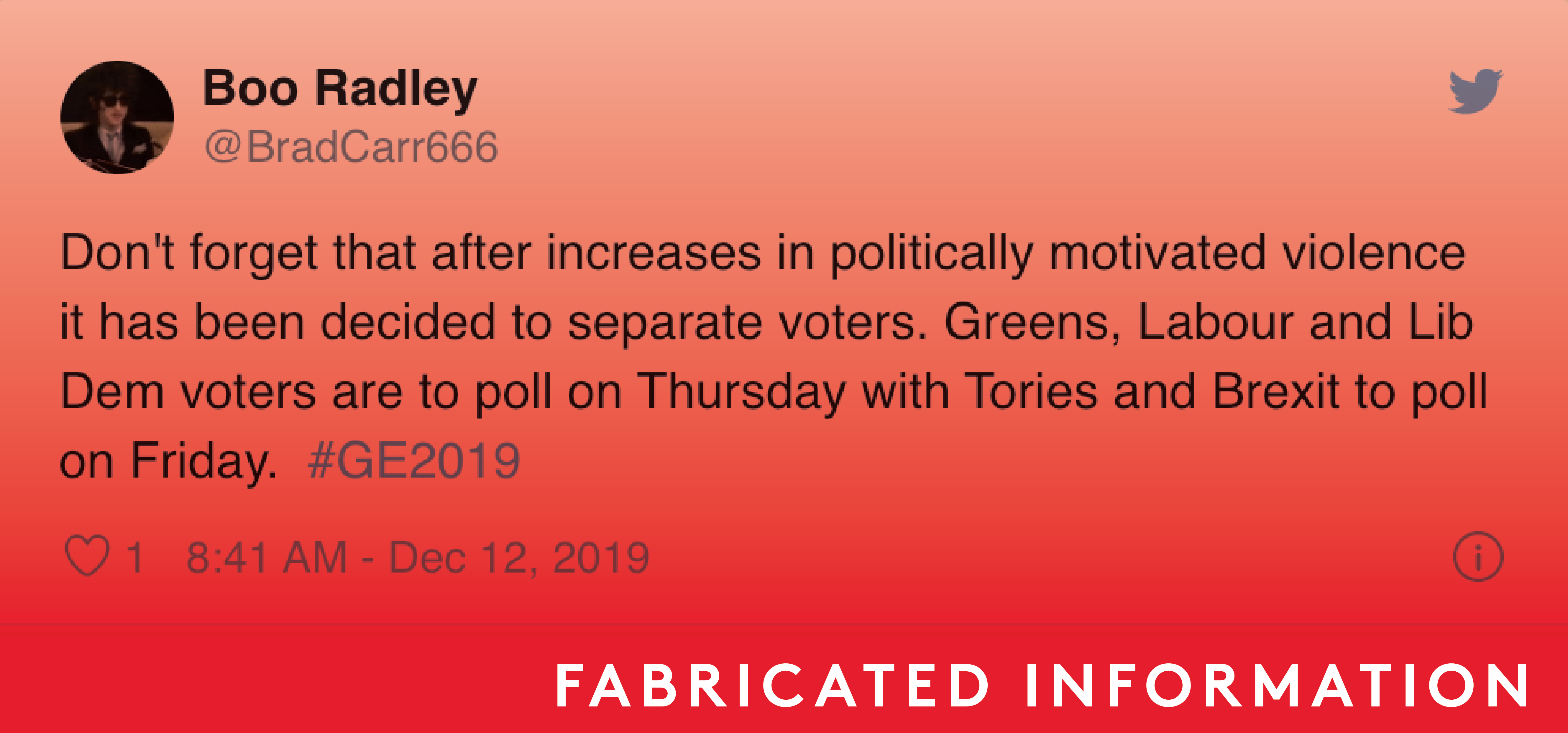
And, of course, no disinformation election is complete without imposter accounts.
An account masquerading as poll aggregator Britain Elects circulated fake polling predictions on Twitter using the handle @brianelects. It even went as far as to use Twitter’s new feature of hiding replies for anyone who called out the falsehoods.
Elsewhere, a fake exit poll forecast by Twitter account @MomentumCV predicted a Labour victory before the official exit poll numbers surfaced. The @brianelects post has since been taken down.
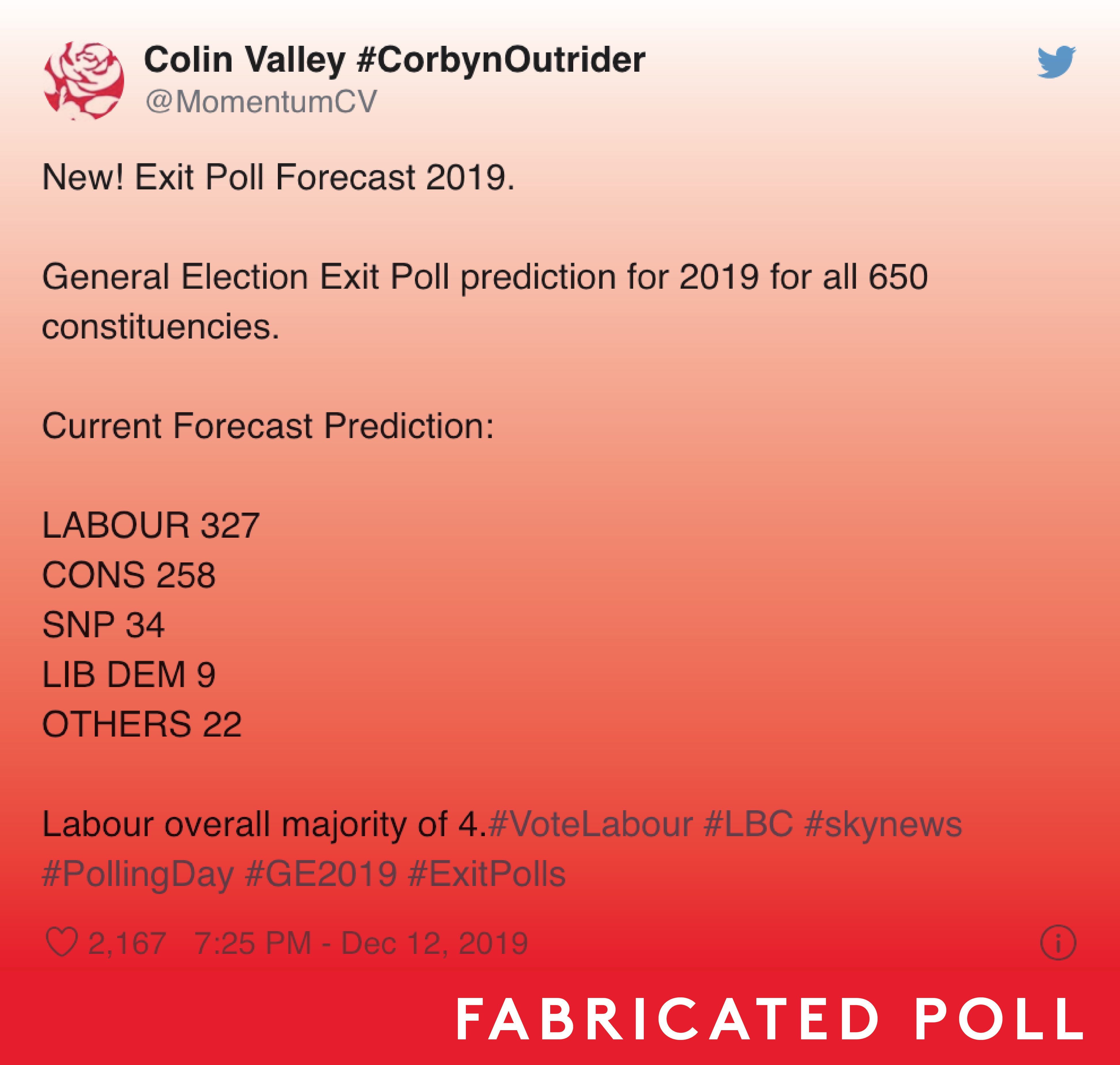
An editor at left-leaning outlet Novara Media claimed “thousands” of people were turned away from polling stations for not having their polling card or identification but First Draft was unable to verify this claim.
There were genuine, isolated cases of people wrongly asked for identification or polling cards at voting booths in England, Scotland and Wales. While ID is required to vote in Northern Ireland, it is not in the rest of the UK.
In Scotland, a council became a source of misinformation relating to the voter process after Perth and Kinross wrongly advised voters on social media that they needed ID to vote. The authority later apologised and reassured voters they could cast their ballot without identification.
In a case verified by First Draft, a voter in East Hertfordshire could only cast their ballot once he complained and after polling station staff contacted the council directly.
Have you received a letter like this after trying to register to vote?
Have you moved address in the same constituency?
Go and vote. My boy got this letter and still went to the polls, was told he can’t vote. Got them to call up and double check. Guess what… plz RT #GE2019 pic.twitter.com/gGsl58LmKr— Mark Crown (@kingcrowney) December 12, 2019
While many of these were isolated incidents, there were several reports of issues with student voter registration at Cardiff University and Southampton University, where hundreds were unable to vote after administrative errors.
Think ‘SHEEP’ before you share
Given that it only takes the click of a button to share something online, people rarely stop to fully scrutinise the content they share, particularly if they agree with it. Throughout the six weeks of election campaigning, social media users in the UK shared falsehoods online in droves.
To help people protect themselves from spreading content containing spin, propaganda and outright disinformation online, First Draft assembled a mnemonic to help people remember to stop and check.
Scrutinising a social media post’s source and its history, any evidence provided to back up its claims, whether it relies on emotion to make a point and its use of pictures, we believe, can prevent people from amplifying mis- and disinformation.
SHEEP is a handy acronym to remember the essential checks to carry out before hitting ‘share’.

Graphic by: Lydia Morrish/First Draft
Leeds General Infirmary become a focal point of an election hoax
A Daily Mirror photo of a four-year-old boy lying on the floor of a hospital in Leeds dominated the beginning of the news cycle during election week after it became the springboard for misreporting and a viral hoax. With disinformation coming from both official and unofficial sources, the incident was a microcosm for issues around the quality of information circulating in the election on the whole.
The photo took on a greater level of controversy after Boris Johnson pocketed an ITV reporter’s phone who had attempted to show the PM the photo. The incident was shared widely but it was quickly overtaken by two separate pro-Conservative disinformation campaigns.
First, high-profile journalists including Robert Peston and Laura Kuenssberg, ITV and BBC political editors respectively, reported that a Labour activist at the Leeds hospital had punched an advisor to the health secretary in the face.
However, footage soon emerged showing the advisor accidentally walking into the activist’s hand. Both political editors deleted the tweets and acknowledged their errors, saying their information had come from “senior Tories”.
[Thread]1/ This one is about the fake news claiming that a sick boy on the floor of a hospital in leeds was staged by his mother. We know the story is real, Dr Yvette Oade, chief medical officer at Leeds even apologised https://t.co/3HNvsR2PWJ
— Marc Owen Jones (@marcowenjones) December 9, 2019
The photo of the four-year-old boy then became the centre of a coordinated conspiracy theory that claimed it was staged by leftwing political group Momentum. On Tuesday, mysterious Facebook and Twitter accounts shared copy-and-pasted statements, including one claiming to know a nurse who had information that the image was orchestrated.
This spread across social media despite the hospital accepting and apologising for the event. Again, a journalist was responsible for spreading the misinformation, with Telegraph columnist Allison Pearson among those retweeting the screenshot.
Voters complain about Lib Dem misinformation tactics on social media
A First Draft investigation found 45 users in 33 constituencies tweeting about letters that they received purportedly from an “elections and polling” expert Mike Smithson. It is only the fine print at the bottom that reveals the letters were distributed by “M. Dixon (the Lib Dems’ CEO) on behalf of the Liberal Democrats”. There is no party branding nor any reference to Smithson’s connection to the Liberal Democrats, for whom he was a councillor and parliamentary candidate.
Very disappointing to see @MSmithsonPB taking part in this dishonest & misleading @LibDems electioneering. Giving the wrong advice in marginals only makes a Tory majority more likely. Note absence of Lib Dem logo as this poses as “independent” advice (but see the small print). pic.twitter.com/kO8T5xqcNe
— Martin O’Neill (@martin_oneill) December 2, 2019
The letters cited a tactical voting website www.getvoting.org which they claimed recommended voting for the Lib Dems – First Draft found that the site recommended voting Lib Dem in only 17 of these seats.
In addition, First Draft found complaints of Facebook ads that said that “only the Liberal Democrats can [defeat the other parties] in seats like yours”. Users complained of seeing these ads in constituencies where the Lib Dems are not predicted to challenge the other parties to win, such as in Warwick and Leamington – a marginal between Labour and the Conservatives, with the Lib Dems projected to get only 6% of the vote, according to YouGov’s 2019 voting intention poll.
The party declined to comment on the literature, but a spokesperson told First Draft “we do not have the capacity to look into [the issue of the Facebook ads] at the moment”.
Disinformation: a ‘vehicle’ to undermine marginalised voices
Abuse of MPs has increased significantly since the 2016 referendum, particularly for ethnic minorities and women. Following research highlighting two prominent black MPs as receiving huge volumes of racist abuse, First Draft investigated some of the disinformation tactics used to undermine their credibility.
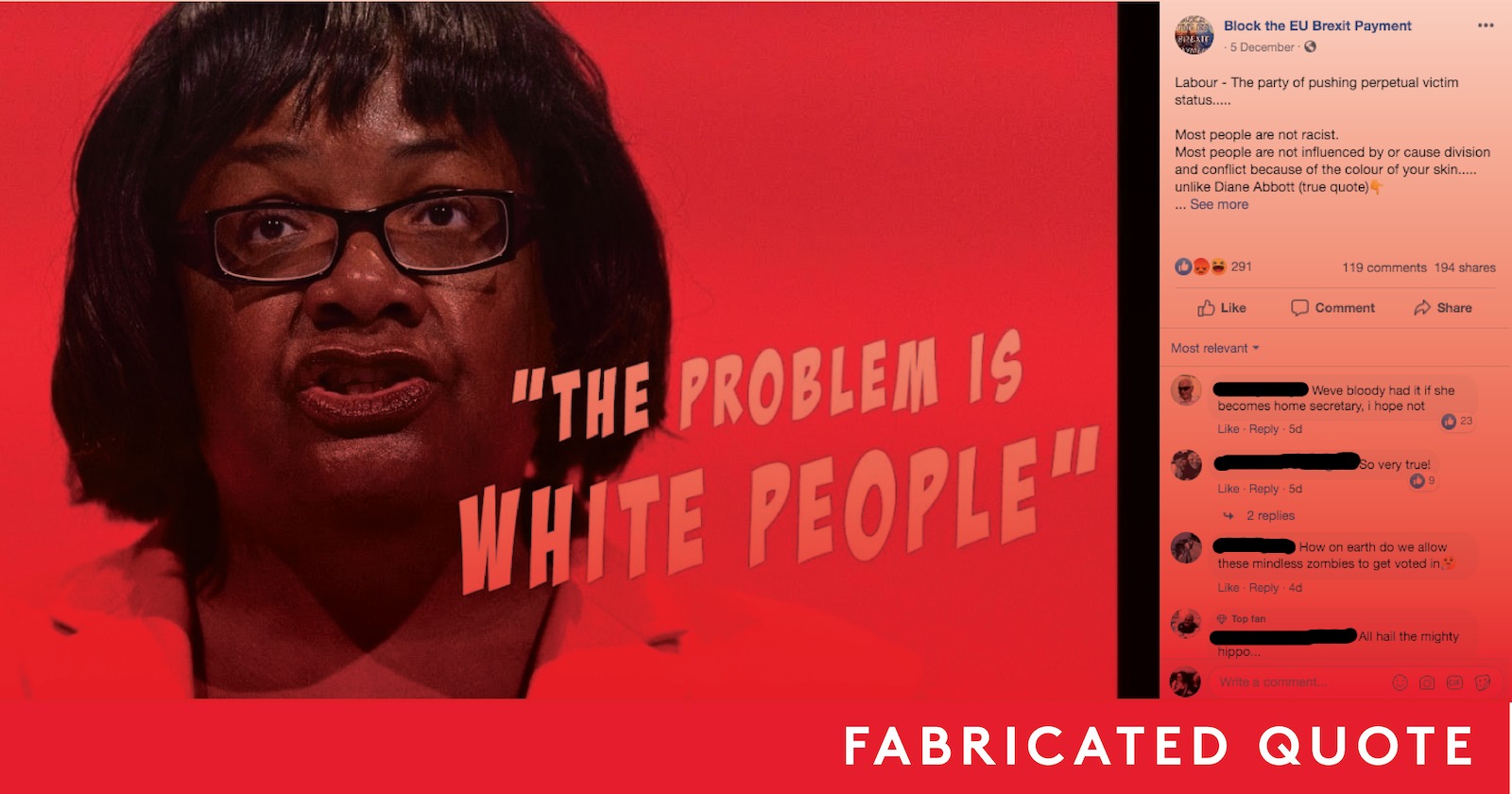
In the lead-up to the election, we found misleading claims, edited videos and conspiracy theories targeting Diane Abbott and David Lammy. These included attributing fake quotes to Abbott, a lie about Lammy’s expenses and the falsehood that he fell asleep in parliament.
Azmina Dhrodia, the author of an influential Amnesty International report on abuse of British female MPs, drew a direct correlation between disinformation, abuse and the prejudice facing minority MPs.
“This disinformation acts to fuel the underlying discrimination that exists offline,” she told First Draft. “It’s all just manifesting online — disinformation is just another vehicle to perpetuate that.”
Read the rest of First Draft’s coverage from throughout the 2019 UK general election.
Stay up to date with First Draft’s work by becoming a subscriber and follow us on Facebook and Twitter.



